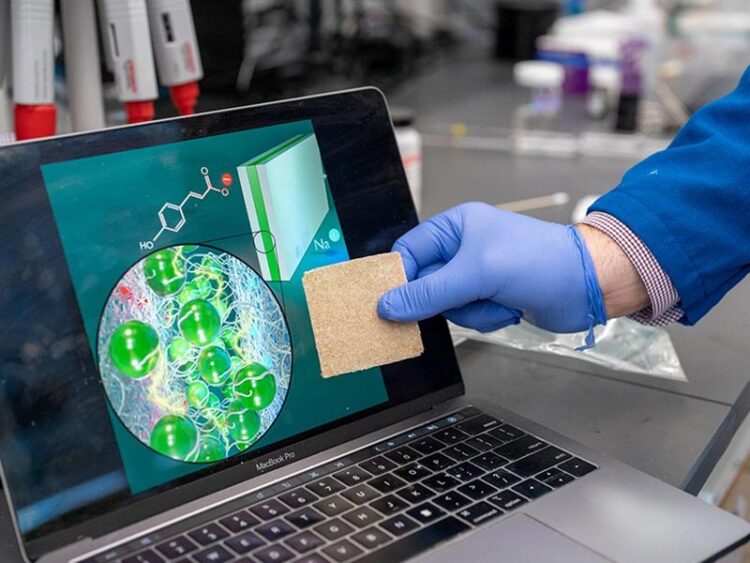Water treatment method to capture acids from agricultural waste

A Penn State-led research team has invented a new class of ion-exchange membrane wafer assemblies that significantly improves electrodeionizaton’s ability to capture p-coumaric acid from liquid mixtures. Researchers improved upon the resin wafers (shown at right), allowing them to improve the process. The paper was selected as ACS Sustainable Chemical Engineering's January 23 journal cover, shown on the computer screen at left.
Credit: Jeff Xu/Penn State
Bound for the landfill, agricultural waste contains carbon sources that can be used to produce high-value compounds, such as p-coumaric acid, which is used in manufacturing pharmaceuticals. Electrodeionization, a separation method that uses ion-exchange membranes, is one way to capture the acids and other useful components. However, to capture large quantities at scale, improvements to the method must be made.
A Penn State-led research team has invented a new class of ion-exchange membrane wafer assemblies that significantly improves electrodeionizaton’s ability to capture p-coumaric acid from liquid mixtures while using less energy and saving money. The researchers published their results in ACS Sustainable Chemical Engineering. Their article also was selected for the journal’s Jan. 23 cover.
First commercialized to purify water, electrodeionization has been used to capture valuable components from waste streams in recent years. In the process, a liquid mixture stream is fed through a stack of several ion-exchange membranes and resin wafers, which resemble a sponge and are held together with a polymer adhesive. When electricity is applied, the ions in the liquid move through the stack, and p-coumaric acid separates into a concentrated process stream, where it can then be collected.
“To improve the process, we had to improve upon the resin wafer,” said corresponding author Chris Arges, Penn State associate professor of chemical engineering. “Previously, the membranes would sandwich the resin wafer sponge with a polyethylene adhesive, which is currently used in industry as resin ‘glue,’ but this led to poor contact between the membrane and resin wafer. We substituted the polyethylene with imidazolium ionomer, a type of polymer, and glued an imidazolium membrane on top of the resin wafer.”
By gluing the membrane to the wafer, the researchers reduced the amount of membrane needed by 30%, reducing the cost of the electrodeionization unit. The new design also reduced the interfacial resistance between the membrane and the wafer, as the same membrane and binder chemistries were glued together rather than sitting on top and below the sponge with air gaps. Reducing the resistance led to an increased rate of capturing p-coumaric acid, allowing researchers to use a smaller unit.
“We knew the new material was capturing more p-coumaric acid, but we were not sure why,” Arges said. “Our collaborator Revati Kumar ran simulations to find out why it worked better.”
Kumar, associate professor of chemistry at Louisiana State University, found the imidazolium increases the solubility of the p-coumaric acid and spurs faster diffusion within the material.
“Multiplied together, solubility and diffusion equal permeability, or how fast we remove the acid as it travels across the membrane resin wafer network into the concentrate compartment,” Arges said.
Arges compared permeability to the rate of travelers going through an airport security line. As more security checkpoints are added, more people can move through the line, increasing the line’s permeability.
Increased permeability, therefore, decreases the chances of the p-coumaric acid binding to the to the membrane-resin wafer materials, known as fouling, instead of moving across the membrane.
“The imidazolium membrane resin wafer assembly promotes the flow of p-coumaric acid through the membrane, which is a problem when other materials, like polyethylene, are used,” Arges said.
When benchmarked against the current resin wafer configuration, the new membrane configuration and materials result in a sevenfold increase in p-courmaric acid capture while using 70% less energy, according to researchers. The new assemblies also decrease the amount of membrane used in the process, resulting in significant cost savings.
Arges’ collaborators at Argonne National Laboratory filed for a patent for the novel membrane-wafer assembly technology.
In addition to Arges and Kumar, the co-authors include Matthew Jordan, Hishara Keshani Gallage Dona and Dodangodage Ishara Senadheera, Louisiana State University; and Grzegorz Kokoszka and Yupo J. Lin, Argonne National Laboratory.
The United States Department of Energy supported this work.
Journal: ACS Sustainable Chemistry & Engineering
DOI: 10.1021/acssuschemeng.2c05255
Method of Research: Experimental study
Subject of Research: Not applicable
Article Title: Integrated Ion-Exchange Membrane Resin Wafer Assemblies for Aromatic Organic Acid Separations Using Electrodeionization
Article Publication Date: 11-Jan-2023
Media Contact
Adrienne Berard
Penn State
akb6884@psu.edu
All latest news from the category: Life Sciences and Chemistry
Articles and reports from the Life Sciences and chemistry area deal with applied and basic research into modern biology, chemistry and human medicine.
Valuable information can be found on a range of life sciences fields including bacteriology, biochemistry, bionics, bioinformatics, biophysics, biotechnology, genetics, geobotany, human biology, marine biology, microbiology, molecular biology, cellular biology, zoology, bioinorganic chemistry, microchemistry and environmental chemistry.
Newest articles

First-of-its-kind study uses remote sensing to monitor plastic debris in rivers and lakes
Remote sensing creates a cost-effective solution to monitoring plastic pollution. A first-of-its-kind study from researchers at the University of Minnesota Twin Cities shows how remote sensing can help monitor and…

Laser-based artificial neuron mimics nerve cell functions at lightning speed
With a processing speed a billion times faster than nature, chip-based laser neuron could help advance AI tasks such as pattern recognition and sequence prediction. Researchers have developed a laser-based…

Optimising the processing of plastic waste
Just one look in the yellow bin reveals a colourful jumble of different types of plastic. However, the purer and more uniform plastic waste is, the easier it is to…



